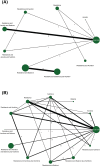Exercise for sarcopenia in older people: A systematic review and network meta-analysis
- PMID: 37057640
- PMCID: PMC10235889
- DOI: 10.1002/jcsm.13225
Exercise for sarcopenia in older people: A systematic review and network meta-analysis
Abstract
Background: Sarcopenia is a serious public health concern among older adults worldwide. Exercise is the most common intervention for sarcopenia. This study aimed to compare the effectiveness of different exercise types for older adults with sarcopenia.
Methods: Randomized controlled trials (RCTs) that examined the effectiveness of exercise interventions on patient-important outcomes for older adults with sarcopenia were eligible. We systematically searched MEDLINE, Embase and Cochrane Central Register of Controlled Trials via Ovid until 3 June 2022. We used frequentist random-effects network meta-analyses to summarize the evidence and applied the Grading of Recommendations, Assessment, Development, and Evaluations framework to rate the certainty of evidence.
Results: Our search identified 5988 citations, of which 42 RCTs proved eligible with 3728 participants with sarcopenia (median age: 72.9 years, female: 73.3%) with a median follow-up of 12 weeks. We are interested in patient-important outcomes that include mortality, quality of life, muscle strength and physical function measures. High or moderate certainty evidence suggested that resistance exercise with or without nutrition and the combination of resistance exercise with aerobic and balance training were the most effective interventions for improving quality of life compared to usual care (standardized mean difference from 0.68 to 1.11). Moderate certainty evidence showed that resistance and balance exercise plus nutrition (mean difference [MD]: 4.19 kg) was the most effective for improving handgrip strength (minimally important difference [MID]: 5 kg). Resistance and balance exercise with or without nutrition (MD: 0.16 m/s, moderate) were the most effective for improving physical function measured by usual gait speed (MID: 0.1 m/s). Moderate certainty evidence showed that resistance and balance exercise (MD: 1.85 s) was intermediately effective for improving physical function measured by timed up and go test (MID: 2.1 s). High certainty evidence showed that resistance and aerobic, or resistance and balance, or resistance and aerobic exercise plus nutrition (MD from 1.72 to 2.28 s) were intermediately effective for improving physical function measured by the five-repetition chair stand test (MID: 2.3 s).
Conclusions: In older adults with sarcopenia, high or moderate certainty evidence showed that resistance exercise with or without nutrition and the combination of resistance exercise with aerobic and balance training were the most effective interventions for improving quality of life. Adding nutritional interventions to exercise had a larger effect on handgrip strength than exercise alone while showing a similar effect on other physical function measures.
Keywords: evidence synthesis; exercise; network meta-analysis; older adults; sarcopenia.
© 2023 The Authors. Journal of Cachexia, Sarcopenia and Muscle published by John Wiley & Sons Ltd on behalf of Society on Sarcopenia, Cachexia and Wasting Disorders.
Conflict of interest statement
The authors declare no conflicts of interest.
Figures




Comment in
-
Apples to apples? Discordant definitions still hinder evidence-based treatments for sarcopenia.J Cachexia Sarcopenia Muscle. 2023 Dec;14(6):2460-2461. doi: 10.1002/jcsm.13339. Epub 2023 Sep 21. J Cachexia Sarcopenia Muscle. 2023. PMID: 37735928 Free PMC article. No abstract available.
References
-
- Morley JE. Sarcopenia: diagnosis and treatment. J Nutr Health Aging 2008;12:452–456. - PubMed
Publication types
MeSH terms
LinkOut - more resources
Full Text Sources
Medical

